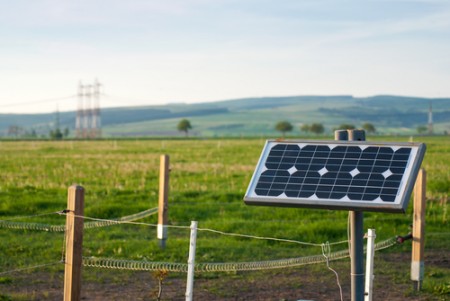By Alyson Kenward, Climate Central
Since the solar energy technology manufacturer Solyndra filed for bankruptcy in late August, there’s been mounting concerns about whether America’s “green jobs” are at risk, and if renewable energy subsidies from the government are in jeopardy. But the pessimism and partisanship in Washington regarding Solyndra (and other cutting-edge energy firms that have received Energy Department loans) is clouding the bigger picture: solar energy is actually one of the fastest growing industries in the country, and there are more people working in solar technology today than in greenhouse gas intensive coal mines and steel factories.
With so many companies in the solar game, this controversy may well be just a small hiccup along solar’s path to becoming a major source of America’s electricity.

But what is solar energy’s timeline? Is it already on the verge of replacing fossil fuels, such as coal and natural gas, or will it take decades before we see solar energy contribute a significant proportion of the nation’s energy supply?
Well, that depends a lot on how hard the U.S. pushes policies that would boost cleaner, renewable sources of energy.
Here’s a snapshot of the current state of solar energy in America.
Today, there are about 3.1 gigawatts (GW) of solar power capacity in the U.S., which can supply energy to up to half a million homes. Yet, compared to coal and natural gas-fired power plants, which emit harmful greenhouse gases, solar provides a tiny percentage of the U.S.’s overall energy. As a share of all the energy used in this country last year, solar only contributed about 0.1 percent.
But that low number hides the fact that solar energy is in the middle of a growth spurt. In 2010, domestic solar capacity grew twice as much as it did in 2009. And this year new solar installations will likely more than double what was built last year. Today, about a third of this country’s solar power comes from residential rooftop panels, but that share is shrinking as larger installations are built.
Massive solar farms, like Florida’s DeSoto Next Generation Solar Energy Center, are the fastest growing part of the industry. Analysts say that 12 GW in new solar farms are slated for development in the next four years.
One reason that solar electricity hasn’t taken off even faster is that it’s usually far more expensive than the electricity generated from existing coal, natural gas, or nuclear power plants. Because most power plants have been around for decades and were paid off long ago, their electricity only costs as much as the fuel used to generate it.
If you’re comparing the cost of building new solar to new fossil fuel or nuclear power plants, however, the costs are tilting in favor of solar. The U.S. Department of Energy says that by 2020, solar-generated electricity will cost around 7 cents per kilowatt-hour, which would be cheaper than electricity from a new coal, natural gas, or nuclear power plant. And while there’s currently no charge on carbon emissions from burning fossil fuels in the U.S., that kind of fee would quickly make solar and other renewable technologies more competitive.
The solar industry has also faced the added hurdle of high costs for manufacturing solar panels. Intense research is now rapidly driving costs down, however, and as more solar panels are manufactured they are getting much more affordable. Now, both national and state-level subsidies are beginning to offset the cost of installing new panels.
Not convinced that renewable energy subsidies and carbon taxes that drive up the cost of fossil-fuel derived electricity would help level the playing field for solar? Take a look at Germany; thanks to an incentive that helps make renewable energy more affordable, Germany built over 7 GW of solar capacity in just one year. They are still only getting 2 percent of their electricity from solar, but that number is climbing quickly. If the U.S. takes a similar approach to making solar energy affordable and competitive — and if we all use electricity more efficiently — then increasing solar energy until it offers a sizeable portion of our electricity is quite feasible.
It’s true that solar energy can only be generated while the sun is shining, which means we can’t rely on it for all of our energy needs, but it does have enormous potential to help meet our peak electricity demands. After all, thanks to air conditioning, we use more energy on warm summer afternoons than at any other time, and that coincides with when solar energy intensity is at its highest.
Tapping into solar power’s vast potential isn’t something the U.S. can do overnight, and it certainly won’t be easy. But expanding solar to meet our electricity needs is a clear way to help lower greenhouse gas emissions and minimize our impact on the climate.
![]() Editor’s Note: This column comes to us as a cross post courtesy of Climate Central. Author credit for the post goes to Alyson Kenward.
Editor’s Note: This column comes to us as a cross post courtesy of Climate Central. Author credit for the post goes to Alyson Kenward.